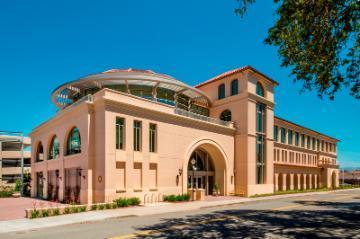Energy Efficiency
- Natural daylight is widely available throughout the building, reducing the need for artificial lighting and reducing overall energy consumption.
- The Edward M. Dowd Art and Art History building features enhanced refrigerant management in accordance with the Montreal Protocol and other policies for eliminating ozone depleting chemicals in refrigeration and air conditioning appliances.
- This building received a full 2 out of 2 points for green power from the LEED Building Design and Construction checklist. This means that the building is powered by renewable energy sources, such as solar or wind power, provided in part by Silicon Valley Power.
Water Conservation and Filtration
- The exterior of the building features water-efficient landscaping and management of stormwater runoff. On the LEED Building Design and Construction checklist, the Edward M. Dowd Art and Art History building received full credit on water-efficient landscaping and stormwater control, and received 3 out of 4 possible points for water use reduction.
Sustainable Design
- This building’s innovation and design process scored a 6/6 on the LEED Building Design and Construction checklist. This process includes, but is not limited to, green education, green cleaning, and onsite renewables.
- The construction site was kept watered down for dust control. Additionally, the site had stormwater management to keep runoff from flowing directly into the storm system.
- The Edward M. Dowd Art and Art History building is located within walking distance of Caltrain's Santa Clara Station and Santa Clara Valley Transportation Authority (VTA) bus stops. Visitors have access to regional public transportation, including CalTrain, Valley Transportation Authority (VTA) buses, and Amtrak. Access to public transportation reduces the need for personal vehicles among students, staff, faculty, and visitors on campus and contributes to Santa Clara University’s culture of sustainability.
Waste Reduction
- Construction waste management scored a 2 out of 2. Construction management waste leaving the site was tracked by the City of Santa Clara’s waste tracking system to ensure that it was going to the recycling facility for sorting and recycling.
- Recycled content and regional materials were used in the building’s construction.
- The Edward M. Dowd Art and Art History building is equipped with standard university recycling, waste, and composting bins. Student work areas have ample recycling and composting capabilities, and students using the building are strongly encouraged to divert their waste from the landfill.
- SCU collects plastics #1-7, paper, aluminum, glass, and tin in “recycle” containers, food waste and biodegradable containers in “compost” containers, and whatever else remains in containers labeled “landfill waste.”
